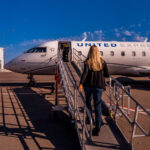Flying ants taking over your backyard? What To Do About Flying Ants? This guide from flyermedia.net provides practical steps to manage these insects, prevent infestations, and understand their role in the ecosystem, offering solutions to address the issue effectively and offering information about other insect pests. Stay tuned for expert insights.
1. What Are Flying Ants and Why Should You Care?
Flying ants, also known as alates, are sexually mature ants, both queens and males, embarking on their nuptial flight. In the UK, the most common species is the black garden ant, Lasius niger, with queens reaching up to 15mm long. Understanding these insects is vital for effective management. Flying ants are not just a nuisance; they indicate a mature ant colony nearby, and addressing them early can prevent larger infestations.
1.1. How to Identify Flying Ants
Distinguishing flying ants from other flying insects is the first step in tackling the problem.
| Feature | Flying Ants (Lasius niger) | Termites |
|---|---|---|
| Body Shape | Narrow waist | Straight body |
| Wings | Two pairs, different sizes | Two pairs, same size |
| Antennae | Elbowed | Straight |
| Color | Black or dark brown | Pale or translucent |
1.2. The Role of Nuptial Flight
The nuptial flight is a critical part of the ant life cycle. According to research from the Royal Society of Biology, swarming is triggered by warm weather and improved conditions compared to the previous day. This flight allows queens to mate with males from different colonies, reducing inbreeding and ensuring genetic diversity.
2. When and Where Do Flying Ants Appear?
Flying ant season typically occurs in July and August, coinciding with hot, humid weather. However, swarms can appear anytime between June and early September. Urban areas often see flying ants earlier than rural areas due to the urban heat island effect. The Royal Society of Biology debunked the idea of a single ‘flying ant day,’ revealing a ‘flying ant season’ with peaks lasting a few days each.
2.1. Predicting Swarming Events
Predicting when flying ants will emerge can help you prepare and take preventive measures.
- Monitor the Weather: Keep an eye on the weather forecast and look for warm, humid days following a period of rain.
- Observe Local Areas: Check gardens, parks, and other areas where ants are likely to nest.
- Use Online Resources: Utilize websites and apps that track insect activity in your area.
2.2. Understanding the Impact of Weather
Weather plays a crucial role in triggering swarming. A study published in Ecography found that ants only fly on warm, windless days with improving conditions.
3. Why Do Ants Fly and Swarm?
Ants fly to mate and establish new colonies. As Suzanne Ryder, Senior Curator at the Natural History Museum, explains, the nuptial flight is the only opportunity for queens to mate and find a new location to start a colony. Swarming provides protection from predators and increases the chances of successful reproduction.
3.1. The Evolutionary Advantage of Swarming
Swarming is an evolutionary strategy that enhances the survival of the species. By appearing in large numbers, flying ants overwhelm predators, increasing the likelihood that some queens will successfully mate and establish new colonies.
3.2. Mating and Colony Formation
During the nuptial flight, queens mate with multiple males. After mating, males die, and queens chew off their wings, seeking a suitable nesting site. They dig an underground chamber and lay their first eggs, sustaining themselves until the first workers can forage for food.
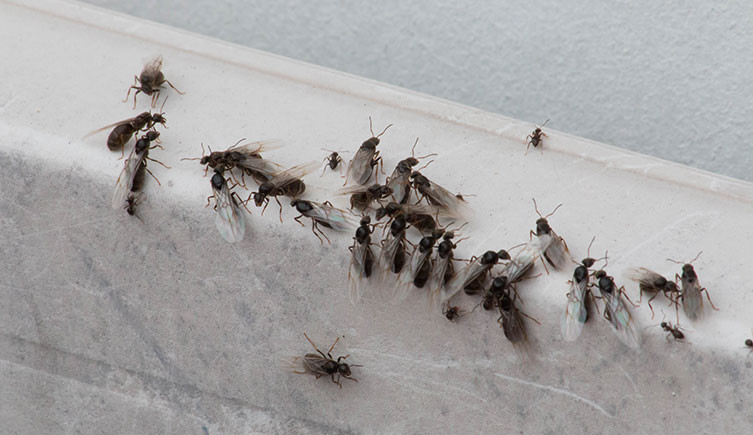 Winged ants on a building
Winged ants on a building
Black garden ant (Lasius niger) The queens are much larger than the worker ants.
4. How to Get Rid of Flying Ants: Immediate Solutions
When flying ants invade your space, quick action is essential. Here are several effective methods to eliminate them.
4.1. Natural Repellents
Natural repellents offer a safe and eco-friendly way to deter flying ants.
- Peppermint Oil: Ants dislike the strong scent of peppermint. Mix a few drops of peppermint oil with water in a spray bottle and apply it to areas where you see flying ants.
- Vinegar: White vinegar is another effective repellent. Spray it directly on ants or wipe down surfaces to deter them.
- Lemon Juice: The acidity of lemon juice disrupts the scent trails of ants. Use it to clean surfaces and repel them.
- Cinnamon: Sprinkle cinnamon powder around areas where ants are entering your home.
4.2. DIY Traps
Creating your own traps can help capture and eliminate flying ants.
- Sugar and Borax Trap: Mix sugar and borax with water to create a sweet but toxic solution. Place it in a shallow container with cotton balls. Ants will be attracted to the sugar, ingest the borax, and die.
- Dish Soap and Water Trap: Mix dish soap with water in a spray bottle. Spraying this solution directly on ants will suffocate them.
4.3. Vacuuming
Vacuuming is a quick and efficient way to remove large numbers of flying ants from your home. Use a vacuum cleaner with a hose attachment to reach ants in corners and crevices. Dispose of the vacuum bag immediately to prevent ants from escaping.
4.4. Professional Pest Control
For severe infestations, professional pest control services may be necessary. Exterminators have access to stronger insecticides and can identify and treat the source of the infestation.
5. Preventing Flying Ant Infestations: Long-Term Strategies
Prevention is better than cure. Implementing long-term strategies can help keep flying ants away from your property.
5.1. Seal Entry Points
Sealing cracks and crevices in your home’s foundation, walls, and around windows and doors can prevent ants from entering. Use caulk or sealant to close any openings.
5.2. Maintain a Clean Environment
Keeping your home clean and free of food debris can reduce the attraction for ants.
- Clean Spills Immediately: Wipe up any spills or food residue as soon as they occur.
- Store Food Properly: Store food in airtight containers to prevent ants from accessing it.
- Regularly Empty Trash Cans: Empty trash cans regularly and keep them tightly covered.
5.3. Manage Garden and Yard Waste
Yard waste and overgrown vegetation can provide nesting sites for ants.
- Remove Piles of Wood: Store firewood away from your home and off the ground.
- Clear Debris: Remove piles of leaves, grass clippings, and other organic debris.
- Trim Vegetation: Keep shrubs and trees trimmed to prevent them from touching your home.
5.4. Use Insecticides Carefully
If necessary, use insecticides strategically to control ant populations.
- Choose the Right Product: Select an insecticide specifically designed for ants.
- Follow Instructions: Carefully follow the instructions on the product label.
- Apply Sparingly: Use insecticides sparingly and only in areas where ants are present.
- Consider Bait Stations: Bait stations can be an effective way to target ants without spreading chemicals throughout your home.
6. Understanding the Benefits of Flying Ants
While they may be a nuisance, flying ants play a vital role in the ecosystem. Their tunneling activities improve soil quality, and they serve as a crucial food source for birds and other animals. Black garden ants are also essential for the survival of the silver-studded blue butterfly.
6.1. Ants as Soil Improvers
Ants aerate the soil through their tunneling activities, improving drainage and nutrient distribution. This can benefit plant growth and overall soil health.
6.2. A Food Source for Wildlife
Flying ants provide a feast for many species, including birds like swifts and gulls. This sudden abundance of food can be crucial for these animals, especially during breeding season.
6.3. The Symbiotic Relationship with Butterflies
Black garden ants and cornfield ants protect caterpillars of the silver-studded blue butterfly from predators. In return, the ants feed on secretions produced by the caterpillars, creating a mutually beneficial relationship.
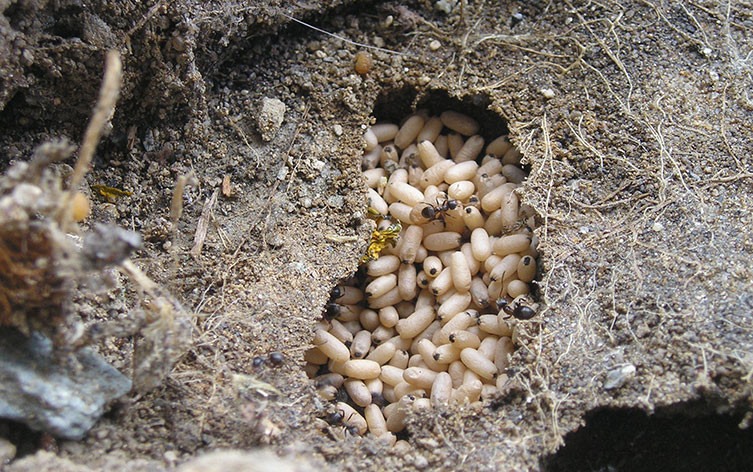 Exposed ant nest
Exposed ant nest
A Lasius niger ant nest that has been exposed when a paving slab was moved. Worker ants and pupae are visible.
7. Common Ant Species in the USA
While Lasius niger is prevalent in the UK, the USA has a variety of ant species, some of which also engage in nuptial flights. Understanding these species can help you tailor your control and prevention strategies.
7.1. Carpenter Ants
Carpenter ants are known for nesting in wood, which can cause structural damage to homes. They are large, black ants that create smooth tunnels inside wood.
7.2. Pavement Ants
Pavement ants are small, brown ants that nest under sidewalks, driveways, and foundations. They often enter homes in search of food.
7.3. Fire Ants
Fire ants are aggressive, reddish-brown ants that deliver painful stings. They build mounds in open areas and can be a nuisance in yards and gardens.
7.4. Argentine Ants
Argentine ants are small, brown ants that form large colonies. They are attracted to sweets and can quickly infest homes.
7.5. Odorous House Ants
Odorous house ants are small, brown ants that emit a foul odor when crushed. They are attracted to sweets and moisture and often nest in walls and under floors.
8. Differentiating Ants from Termites
It’s crucial to distinguish between ants and termites, as their control methods differ. Termites can cause significant structural damage to homes, while ants are generally just a nuisance.
| Feature | Ants | Termites |
|---|---|---|
| Body | Three distinct body sections | Straight, broad body |
| Antennae | Elbowed | Straight, beaded |
| Wings | Forewings longer than hindwings | Both pairs of wings equal size |
| Habitat | Nests in soil or wood | Lives in wood |
9. The Impact of Flying Ants on Aviation
While seemingly unrelated, flying ants can impact aviation, particularly during their swarming season. Swarms can reduce visibility and potentially interfere with aircraft sensors.
9.1. Historical Incidents
There have been instances where large swarms of insects, including flying ants, have affected aircraft operations. These incidents highlight the importance of monitoring insect activity near airports.
9.2. Safety Measures
Airports and aviation authorities take several measures to mitigate the impact of insect swarms.
- Monitoring Insect Activity: Regularly monitoring insect populations near airports.
- Using Insecticides: Applying insecticides to control insect populations.
- Adjusting Flight Paths: Altering flight paths to avoid areas with high insect activity.
- Cleaning Aircraft Sensors: Ensuring aircraft sensors are clean and functioning properly.
10. Frequently Asked Questions (FAQ) About Flying Ants
10.1. What Attracts Flying Ants to My Home?
Flying ants are attracted to food, moisture, and shelter. Open food sources, leaky pipes, and overgrown vegetation can all attract flying ants to your home.
10.2. Are Flying Ants Dangerous?
Flying ants are not dangerous to humans. They do not bite or sting, although some species, like fire ants, can sting.
10.3. How Long Does Flying Ant Season Last?
Flying ant season typically lasts from June to early September, with peak activity in July and August.
10.4. Can Flying Ants Damage My Home?
Flying ants themselves do not cause structural damage to homes. However, their presence may indicate a larger ant colony nearby, which could potentially cause damage.
10.5. What Is the Best Way to Get Rid of Flying Ants?
The best way to get rid of flying ants is to use a combination of natural repellents, DIY traps, and vacuuming. For severe infestations, professional pest control services may be necessary.
10.6. Do Flying Ants Bite?
No, flying ants do not typically bite. Their main goal is to mate and reproduce, not to attack humans.
10.7. Why Are There So Many Flying Ants at Once?
Flying ants swarm in large numbers to protect themselves from predators and increase the chances of successful reproduction.
10.8. What Should I Do If Flying Ants Get Inside My Car?
If flying ants get inside your car, vacuum them out and use insect repellent to deter them from returning.
10.9. Are Flying Ants a Sign of a Termite Infestation?
Flying ants are not a sign of a termite infestation, but it’s essential to distinguish between the two. Termites can cause significant structural damage to homes, while ants are generally just a nuisance.
10.10. How Can I Prevent Flying Ants from Returning Next Year?
To prevent flying ants from returning next year, seal entry points, maintain a clean environment, manage garden and yard waste, and use insecticides carefully.
11. Learn More About Flying and Aviation on flyermedia.net
Interested in the world of aviation? Visit flyermedia.net for the latest news, training opportunities, and career prospects in the aviation industry. Whether you’re a student pilot, aviation enthusiast, or seasoned professional, flyermedia.net offers valuable resources and insights.
11.1. Discover Flight Training Programs
Explore a comprehensive list of flight training programs across the USA. Find the perfect school to kickstart your aviation career.
11.2. Stay Updated with Aviation News
Keep up with the latest developments in aviation, from technological advancements to regulatory changes.
11.3. Explore Career Opportunities
Find job listings and career advice for pilots, engineers, technicians, and other aviation professionals.
12. Act Now: Take Control of Flying Ant Infestations
Don’t let flying ants take over your property. By understanding their behavior, implementing preventive measures, and taking quick action when needed, you can effectively manage these insects and protect your home. For more information and expert advice, visit flyermedia.net today.
Are you eager to find top-notch flight training programs, stay updated with aviation news, and explore exciting career opportunities in the USA? Visit flyermedia.net now and take the first step towards your aviation dreams. Discover a wealth of resources and expert advice tailored to your needs. Don’t wait—your journey into the world of aviation starts here!
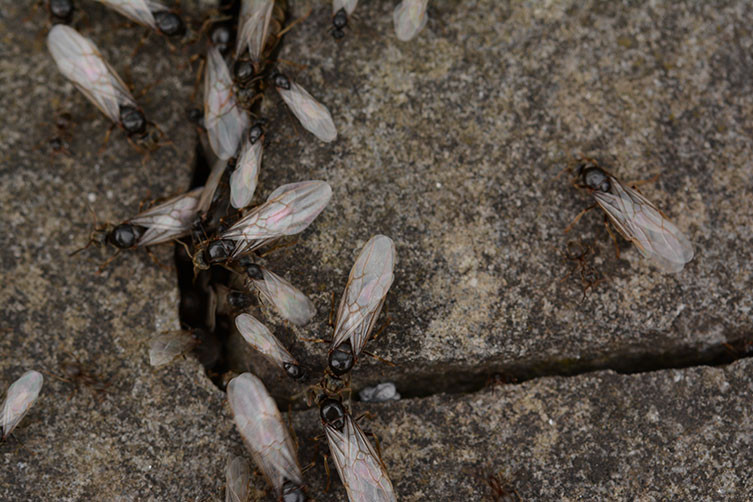 Winged ants about to fly
Winged ants about to fly
In summer, a spell of good weather often leads to sightings of winged ants, called alates, which emerge from their nests
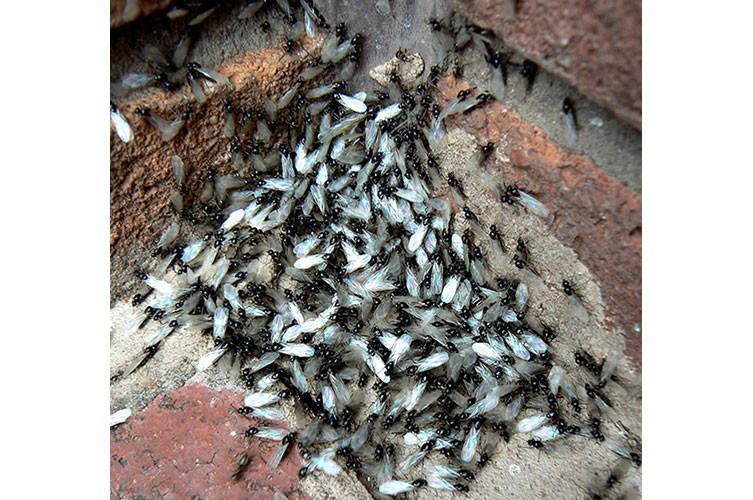 Lots of winged ants in a corner between bricks
Lots of winged ants in a corner between bricks
Winged ants appear in huge numbers when conditions are right. This maximises the chance of successful mating encounters and survival.
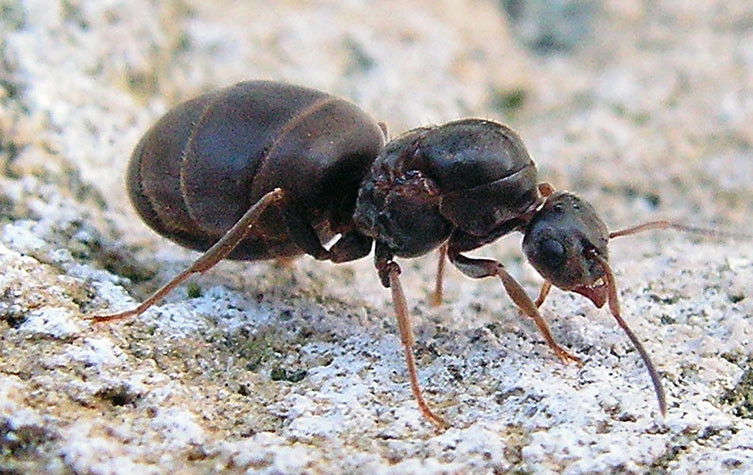 A queen ant that no longer has wings
A queen ant that no longer has wings
This Lasius niger queen has chewed off her wings after mating
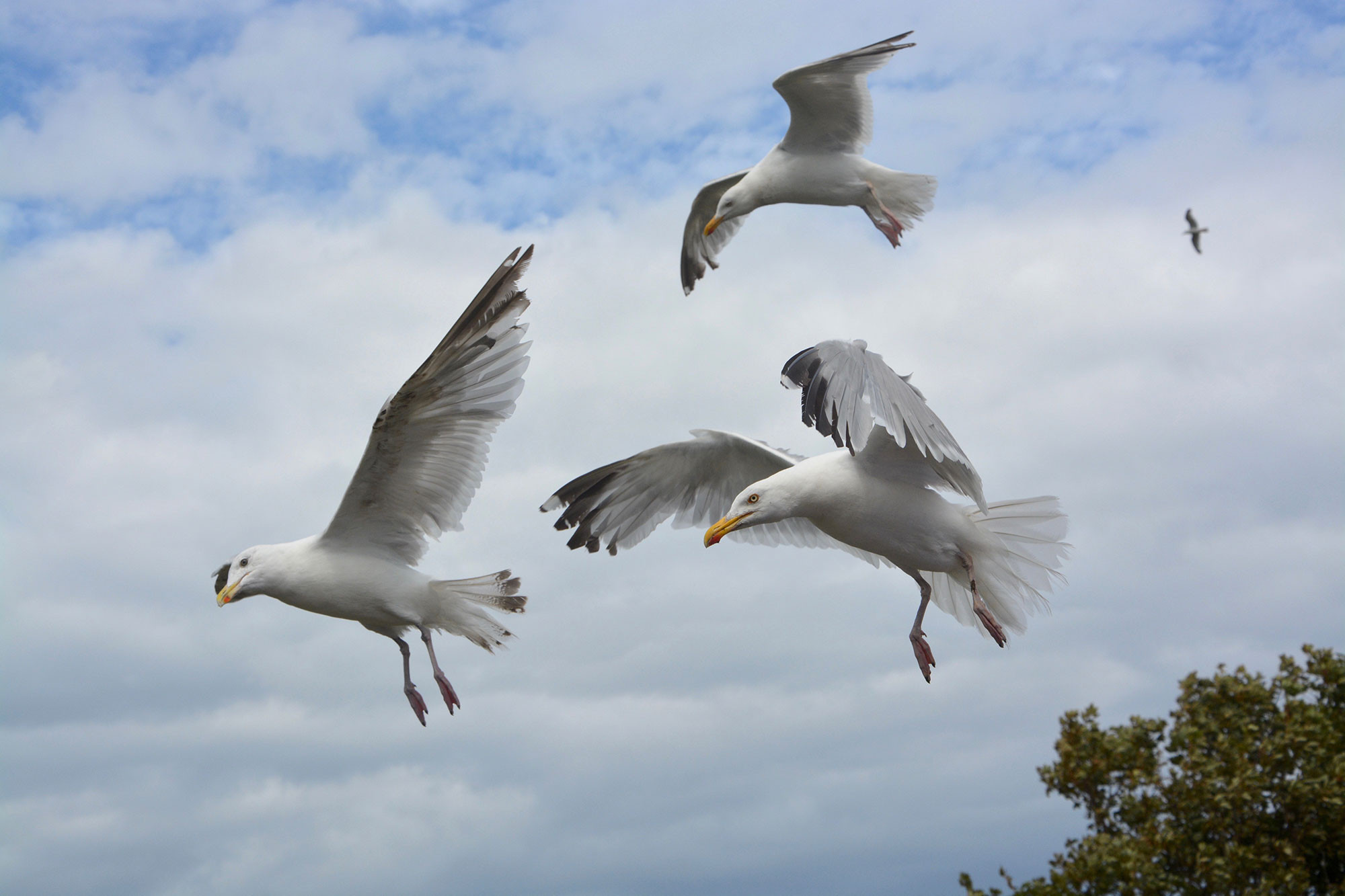 Three flying seagulls
Three flying seagulls
Flying ant day provides a feast for many animals, including gulls. Image courtesy of Pixabay (CC0).
 A few ants on a Plebejus argus caterpillar
A few ants on a Plebejus argus caterpillar
Lasius ants protect caterpillars of the silver-studded blue butterfly (Plebejus argus) in return for food
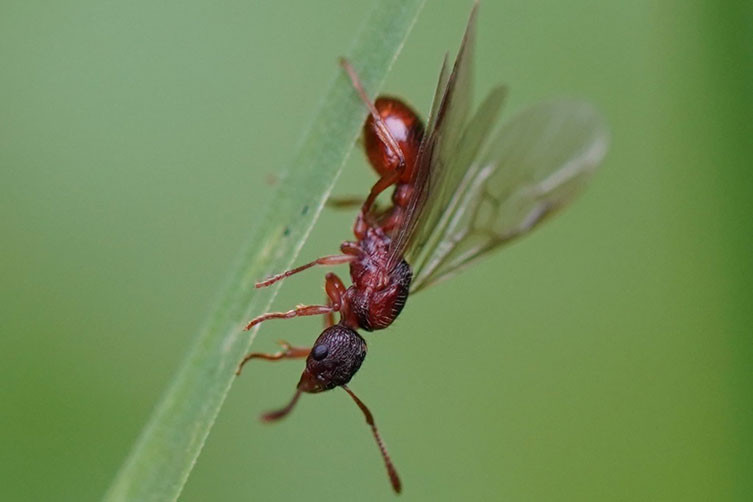 Winged Myrmica rubra ant
Winged Myrmica rubra ant
Winged ant of the species Myrmica rubra, a common red ant in Britain
